The Maximilian Sunflowers are in bloom and in full sun worship. So neat to see hundreds of them all facing the same way, toward that bright ball of energy in the sky!
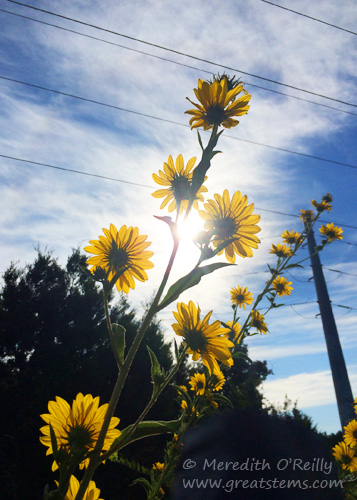
The Maximilian Sunflowers are in bloom and in full sun worship. So neat to see hundreds of them all facing the same way, toward that bright ball of energy in the sky!

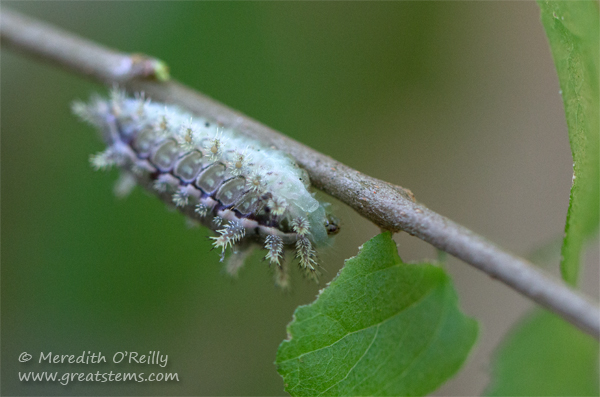 While working on the front yard, we ran across this odd creature at the base of a rogue Hackberry seedling. It seemed fairly obvious that it was some sort of caterpillar, until we saw it move. Then it was like… WHOA. Instead of seeing it move along like a regular caterpillar with its legs and prolegs (though apparently a caterpillar actually moves by its gut), what was visible on this caterpillar was a wavelike motion as it traveled. The closest creature I could compare it to, barring that of something from the ocean, was a slug. Turns out that I was right on the money… its common name is actually “slug caterpillar,” or in this case a Spiny Oak Slug Caterpillar. I’m fairly confident about the ID, except that there seems to be a wide variation in color for these little guys. If I were to guess, their coloration might have something to do with what actually tree they are feeding on, or what instar they might be in, but again, just a guess.
While working on the front yard, we ran across this odd creature at the base of a rogue Hackberry seedling. It seemed fairly obvious that it was some sort of caterpillar, until we saw it move. Then it was like… WHOA. Instead of seeing it move along like a regular caterpillar with its legs and prolegs (though apparently a caterpillar actually moves by its gut), what was visible on this caterpillar was a wavelike motion as it traveled. The closest creature I could compare it to, barring that of something from the ocean, was a slug. Turns out that I was right on the money… its common name is actually “slug caterpillar,” or in this case a Spiny Oak Slug Caterpillar. I’m fairly confident about the ID, except that there seems to be a wide variation in color for these little guys. If I were to guess, their coloration might have something to do with what actually tree they are feeding on, or what instar they might be in, but again, just a guess.
To share this amazing undulating movement, we took a video, seen below. We used a macro to get in close to see the waves, hence the occasional moments when the caterpillar goes out of focus. But the gist of the movement is there.
Since this is the first time I’ve ever run across this type of caterpillar, I don’t have a lot of details about it. It will turn into a moth, and my instincts NOT to touch it were spot on. Like other slug caterpillars in the family, it has a painful sting, though this one is milder than some of its cousins. Also, its thoracic legs are reduced, contributing to those rolling waves being such a predominant feature.
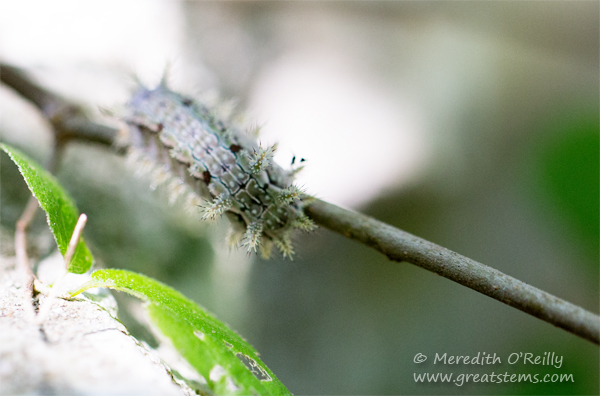 Among its host plants, the Spiny Oak Slug Caterpillar eats the leaves of Oak (no big surprise there), Hackberry (also no surprise), Ash, Cherry, Willow, and many other trees. Though we yanked out the Hackberry seedling — it was growing right in the middle of a multi-trunked Yaupon — we took the caterpillar over to another Hackberry being allowed to grow.
Among its host plants, the Spiny Oak Slug Caterpillar eats the leaves of Oak (no big surprise there), Hackberry (also no surprise), Ash, Cherry, Willow, and many other trees. Though we yanked out the Hackberry seedling — it was growing right in the middle of a multi-trunked Yaupon — we took the caterpillar over to another Hackberry being allowed to grow.
Finding things you didn’t know existed is so fun!
No pictures, just an update. With a sad heart, I have to tell you that our Eastern Screech Owl family suffered a tragic blow. A bee swarm, on the hunt for a new cavity to call home, found our owl house and decided to move in. Unfortunately, our 3 young owlets were still inside, and sadly we couldn’t help them, nor could their parents. The bee colony, in typical swarm fashion, was huge. The bee rescuers who came, along with other folks we talked to, said it was very unusual for bees to move into an occupied house. But our owlets were still quite small, and my guess is the bees didn’t see them as much of a concern.
We are devastated and are mourning the loss of 3 innocent baby owls. Such a pointless death, Mother Nature. But despite our unhappiness at the bees, they now have their own “official” hive and will hopefully work hard making honey for themselves and the beekeepers who rescued them.
Since this is our second swarm in a year, one of the bee rescuers brought out a special bee box to entice the next group of bees to move in there instead of our owl box. Let’s hope it works — perhaps we can be a regular source of bees for them, and something positive will come out of this tragic situation. Mama and Papa Owl, I hope you will return next year.
In all the world, there are only a few species of plants that form rather remarkable ice sculptures when the air outside drops to sub-freezing temperatures. Of those, I’m lucky enough to grow one species, Frostweed (Verbesina virginica), in my garden.
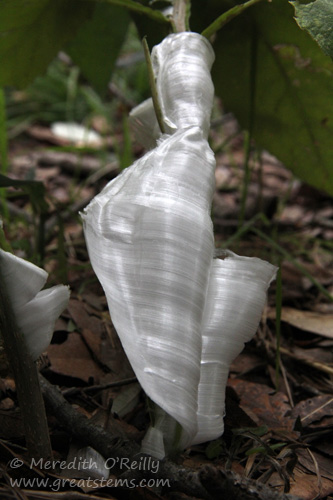 There were two reasons I started growing Frostweed in my wildlife garden. The first is that it is a valuable nectar source for pollinators, especially migrating Monarchs, during its bloom time in the fall. The second is that when conditions are right in the late fall or winter, beautiful curling ice ribbons might exude from the stem’s outer layers.
There were two reasons I started growing Frostweed in my wildlife garden. The first is that it is a valuable nectar source for pollinators, especially migrating Monarchs, during its bloom time in the fall. The second is that when conditions are right in the late fall or winter, beautiful curling ice ribbons might exude from the stem’s outer layers.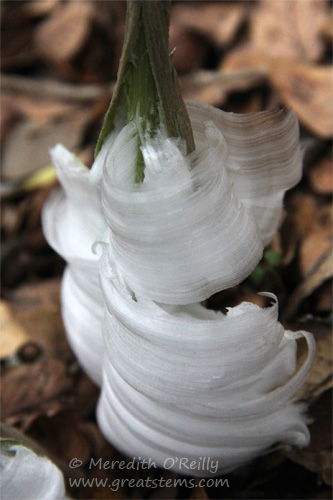 As temperatures drop, supercooled sap increases the pressure between the stem’s secondary xylem core and the epidermis. When the epidermis can no longer withstand the pressure, it splits open. The emerging sap produces the start of icy creations as the water cools quickly and begins to freeze. Then, because the internal pressure was reduced with the split of the epidermis, water from the plant’s roots moves upward and outward toward the split, contributing to the spectacular sculptures.
As temperatures drop, supercooled sap increases the pressure between the stem’s secondary xylem core and the epidermis. When the epidermis can no longer withstand the pressure, it splits open. The emerging sap produces the start of icy creations as the water cools quickly and begins to freeze. Then, because the internal pressure was reduced with the split of the epidermis, water from the plant’s roots moves upward and outward toward the split, contributing to the spectacular sculptures.
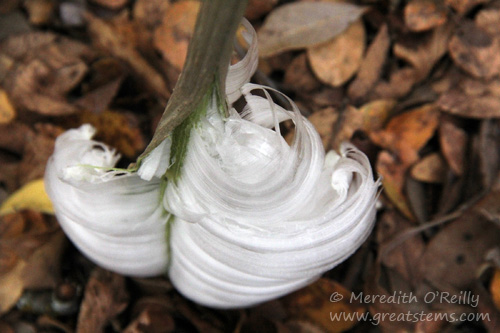
When the water first emerges where the epidermis splits, it does so at right angles to the core, because it exits from single rays which move water peripherally from the pith (center core) toward the living cortex and outer cells, the epidermis.
The beautiful ice ribbons form as water touches adjacent ice crystals and freezes, a repeating process.
The ribbons are thin and delicate. They melt almost instantly when held.
In this image, note the living cortex just inside the epidermis, easily seen where the split starts to taper.
Ice sculptures from Frostweed typically appear at the plant’s base, close to the roots, but this isn’t always the case. Above, the ribbons begin appearing about an inch off the ground. They continue emerging for much of the plant’s stem. As you can see from the plant’s green leaves, the plant was not in a dormant state at the time of the freeze, and water existed well up the stem. This allowed for a particularly impressive ice creation. An unusually hard freeze early in the season might provide the conditions for such a tall sculpture.
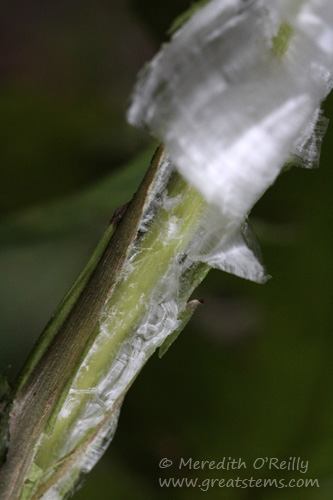 The stem itself does not split. In fact, it can produce additional formations as freezing temperatures occur again in the season. Subsequent formations will usually move lower to the base of the stem, near the roots.
The stem itself does not split. In fact, it can produce additional formations as freezing temperatures occur again in the season. Subsequent formations will usually move lower to the base of the stem, near the roots.
Higher up the stem on a Frostweed plant, decreased pressure might allow the epidermis to split but not emerge forcefully enough to create ribbons.
Why is Frostweed able to do this, while most other plants cannot? A closer study indicates that during freezing temperatures, water must be present in the cortex and tissue just inside the epidermis; typically in Frostweed this occurs at least near base of the plant. Also, the secondary xylem of Frostweed is woody, which allows a framework against which internal pressure from the supercooled sap will push out and lead to the rupture of the epidermis. Additionally, Frostweed’s xylem rays allow water to flow laterally at right angles to the transport tissues, a big factor in the creation of the ice ribbons.
The above image shows the blooms of this excellent wildlife plant. Frostweed grows readily in shade from seed, looking its best in natural woody settings. It can reach heights of 6-8 feet, with clusters of white blooms opening up with copious nectar in fall. I find it a beautiful plant most of the year, but as it grows big, it might flop over, and as the seasons turn cool the foliage admittedly will become less attractive.
It’s amazing how not visiting your veggie garden for a mere three days can be long enough to let naughty little critters establish a hold on your precious edibles. I went out among the raised beds and found near skeletal broccoli and cauliflower plants.
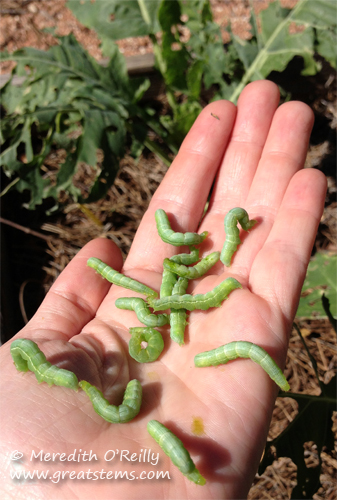 Lifting the remaining leaf bits, I discovered the culprits. Cabbage Loopers — argh! I love caterpillars, seriously I do, but I have to draw the line on those that would eat my veggies down to nothing. Time to hand-pick them off! The total on all the plants: 37 cabbage loopers plus 4 salt marsh caterpillars and possibly 1 banded woolly bear. I moved the fuzzies to other sections of the yard — I know they’ll find plenty to eat over there, such as horseherb. The cabbage loopers, on the other hand — they get to do their part in the ecosystem as food sources for other critters. Originally I planned to put them in the bird feeder trays, but my friend Jan raises turtles, and they LOVE wiggling little caterpillars and itty bitty little wormsies. Perfect.
Lifting the remaining leaf bits, I discovered the culprits. Cabbage Loopers — argh! I love caterpillars, seriously I do, but I have to draw the line on those that would eat my veggies down to nothing. Time to hand-pick them off! The total on all the plants: 37 cabbage loopers plus 4 salt marsh caterpillars and possibly 1 banded woolly bear. I moved the fuzzies to other sections of the yard — I know they’ll find plenty to eat over there, such as horseherb. The cabbage loopers, on the other hand — they get to do their part in the ecosystem as food sources for other critters. Originally I planned to put them in the bird feeder trays, but my friend Jan raises turtles, and they LOVE wiggling little caterpillars and itty bitty little wormsies. Perfect.
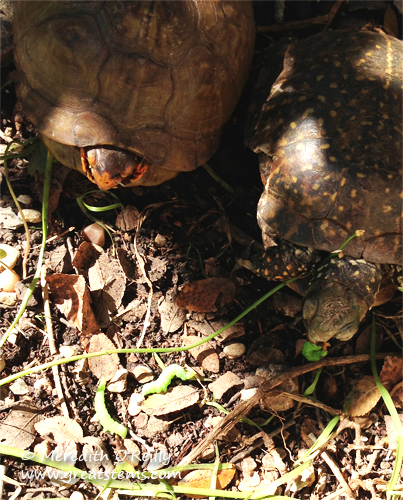
My son headed over to Jan’s to watch the happy turtles and snap a couple of pictures. Here are two of Jan’s turtles beginning to feast.
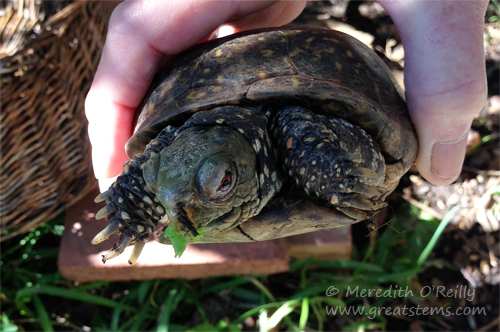 Sorry little caterpillars, but I need my broccoli and cauliflower! I’m hopeful that the plants will recover — they already have new leaves forming.
Sorry little caterpillars, but I need my broccoli and cauliflower! I’m hopeful that the plants will recover — they already have new leaves forming.
Let me start by saying that we are still in a drought here in Central Texas. But tonight we’ve been experiencing another round of flash flood-producing heavy rains, a product of the particular weather systems and geography of the area. While folks in low areas face dangerous rising waters regularly (when there actually is rain, mind you), we’ve been fortunate to live in a house that really hasn’t had a problem, knock on wood. However, with the clouds dumping inches of rain in mere minutes — after having a few substantial rains over the past few weeks — for the first time in the 18 years we’ve been in this house, our house is in danger of flooding.
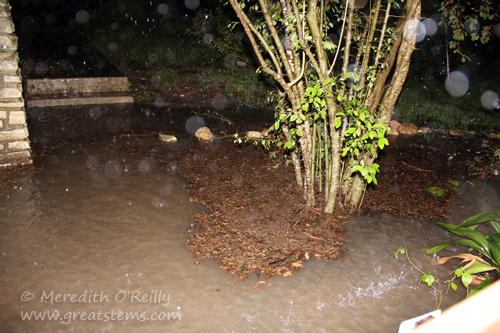
That’s the front of the house.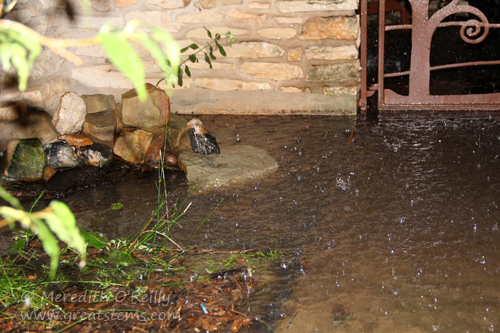
The entryway pond is underwater, too. Good thing we don’t keep fish in that particular pond.
I don’t think we’ll flood — the slope of the land sends most of the water toward the backyard. I’m worried about our neighbors, however, and I’m a little worried that I’ll have new trenches washed out in the back. I know many low-water crossings are deep in water, so hopefully other folks are driving safe. Tomorrow morning will be interesting!
Edit: Our garden rain gauge stops measuring at 5 inches, but our closest two “official” rain gauges in the city report that we’ve had 6-7.5 inches of rain in the past 12 hours, much of which was dumped all at once. I hear rain still outside, with more storms on the radar. It’s both wonderful to have all this rain and so interesting that for once our NW part of Austin is getting serious flooding. Usually central and south Austin spots get that main experience. I sure hope this means that Lake Travis is rising — it’s been depressing how low it has been during the drought.
All the rain we’ve been having lately has brought opportunities to see a huge variety of mushrooms all over the property, in all sizes, shapes, and colors. I love mushrooms. I see them as a sign of a functioning ecosystem and good soil.
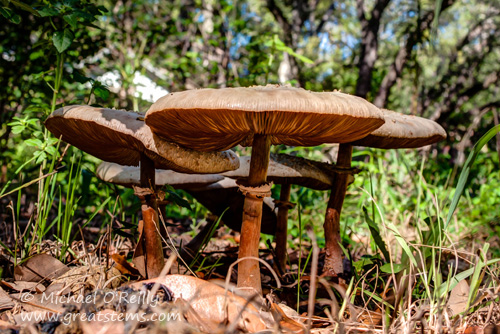
Back in the wooded area near where we hope to build our new shed soon (and I actually mean soon), we were wowed by almost a dozen giant toadstools dotting the ground. They were huge, about the size of my husband’s hand. Definitely “wow” fungi, I have to say.
We’ve had even more rain this week. Now I’m noticing other fungi but the toadstools have gone. Fascinating how mushrooms come and go — you never know what species will pop up next.
I finally updated our list of plants growing in our garden. We’re up to 157 native species and counting! While I’m at it, let me mention that I’ve got a brand new page dedicated to wildlife projects for kids of all ages. These can be accessed any time from the sidebar. I’m feeling so productive!
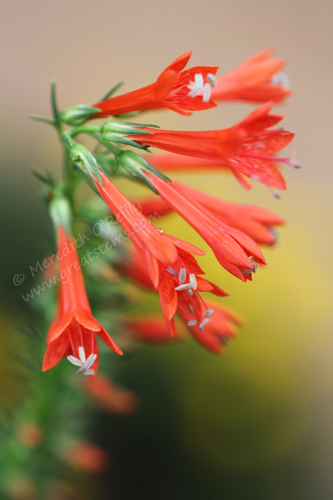 I have to show off the current eye-catcher in the garden, Standing Cypress, Ipomopsis rubra. Tall spikes of brilliantly-colored flowers draw your attention quickly — show stoppers, they are!
I have to show off the current eye-catcher in the garden, Standing Cypress, Ipomopsis rubra. Tall spikes of brilliantly-colored flowers draw your attention quickly — show stoppers, they are!
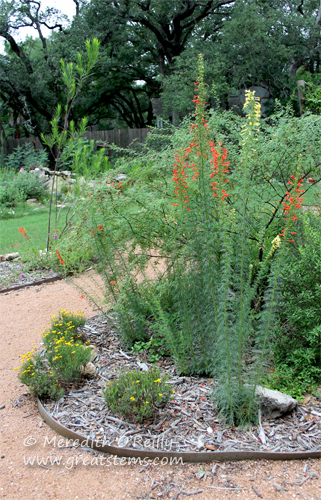
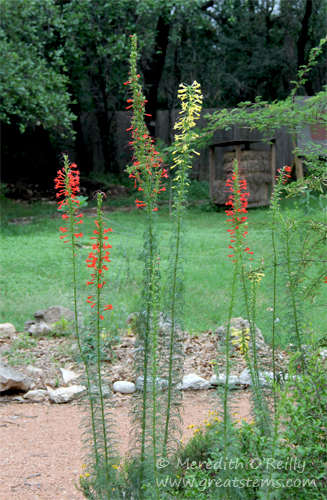
I grew these from seed, simply tossing them all over the front and back yards (which means I have them here, and there, and everywhere!). They are fun little biennial plants. Don’t expect blooms the first year — Year One will simply bring you small rosettes. Year Two is the exciting year — the little rosettes suddenly form growing stalks that keep growing… and growing and growing… and then they stop.
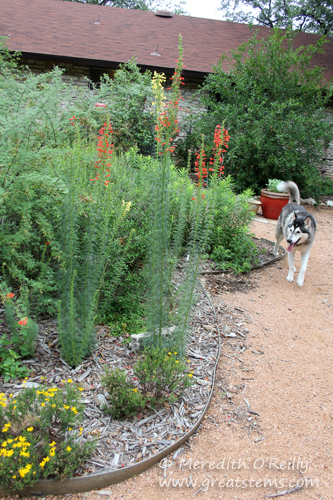
Most of my Standing Cypress bloom stalks are taller than me, and there are quite a few that have reach 6-foot in height, making it fun to measure them against the men in our family. To give you a bit of a size perspective, I present to you in the photo above our Loki, who is much taller than your typical Husky (think wolf-size).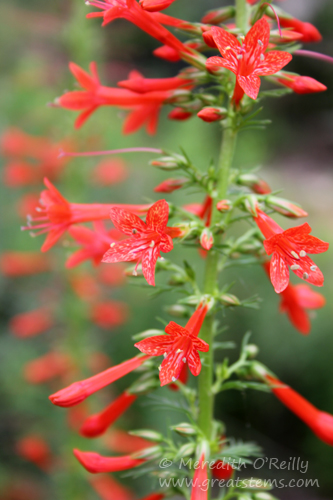
The red tubular blooms make this flower a favorite of… you guessed it… hummingbirds.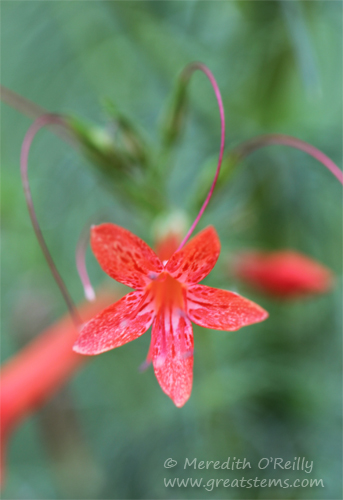
While I was outside taking photos, I could hear the familiar “buzzing” of lighting-fast hummingbird wings — I could tell our garden visitors were annoyed that I was standing near their beloved red blooms. Lucky for them, there are plenty of other flowers in bloom around the garden (and feeders, too). So they might have been annoyed with me but certainly not lacking in alternatives. While we have Standing Cypress all over the place, too, those in shade have not yet opened their buds (they are just really, really tall at the moment).
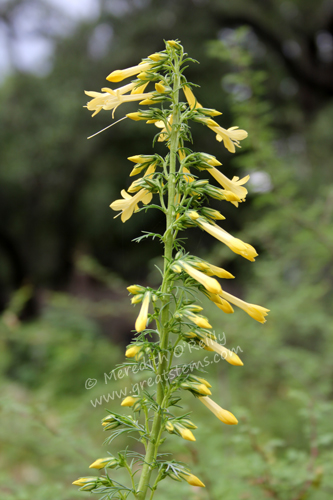
Standing Cypress is generally considered a plant with red blooms, so we were pleasantly surprised to see that we got a few yellow specimens. What a treat!
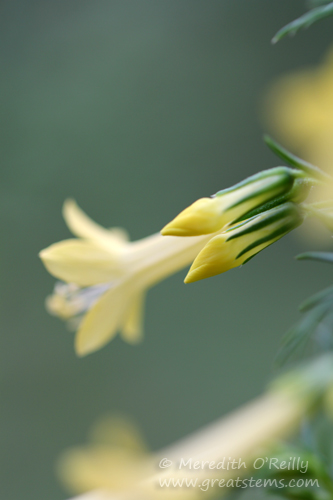
With luck, these lovely plants will naturally reseed, yellow ones included. 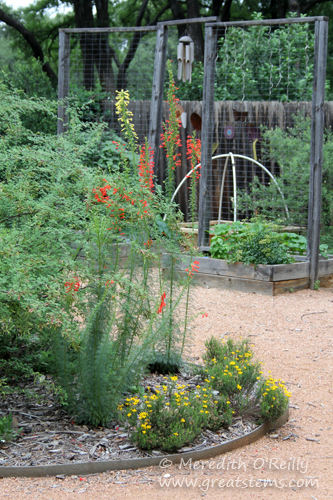
Such a nice pop of color! That’s Damianita out in front. In this spot, later in the year, the White Mistflower and Lindheimer’s Senna will also add their own color. Hopefully some of the Standing Cypress will still be producing blooms at that time for a beautiful color medley.
Each spring, Texas highway roadsides, country fields, and urban gardens take on blue as our beautiful bluebonnets start to bloom. Typically this bloom period is from March to May, and the bounty of blue depends on rain that fell the previous fall and winter.
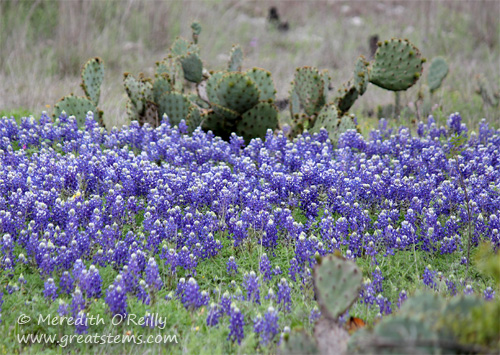 Bluebonnets are part of the legume, or bean, family. Like most other members of the legume family, they offer nitrogen-fixation through their root system’s symbiotic relationship with Rhizobia bacteria, giving them the excellent ability of being able to grow in poor, disturbed soils and at the same time bringing nitrogen back to that poor soil when they decompose.
Bluebonnets are part of the legume, or bean, family. Like most other members of the legume family, they offer nitrogen-fixation through their root system’s symbiotic relationship with Rhizobia bacteria, giving them the excellent ability of being able to grow in poor, disturbed soils and at the same time bringing nitrogen back to that poor soil when they decompose.
Bluebonnets require insect pollination, and bumblebees and honeybees take on this job quite readily. The flowers are designed to encourage this pollination. Let’s take a closer look.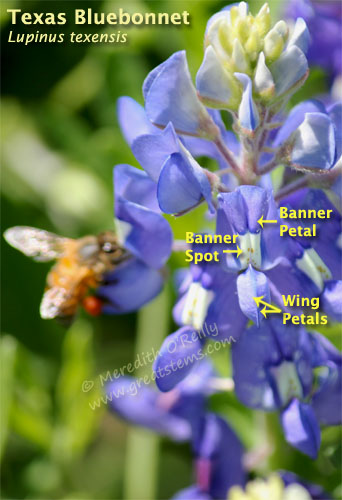
Bluebonnet flowers are made up of many florets. Each floret has 5 petals: the banner petal, 2 wing petals, and 2 petals that make up the keel (next photo). The banner petal forms the upper part of the floret. The center of this petal is called the banner spot, and it is this spot that acts as a target to attract bee pollinators. When the pollen is fresh and sticky, the banner spot is white, seen to bees as reflected UV light and appearing to them to be a nice landing spot. But as the floret and its pollen age, the banner spot turns a reddish-magenta color and becomes ignored by the bees, who can’t see red. Take a moment to watch bees buzzing around bluebonnets — which color banner spots do they visit the most?
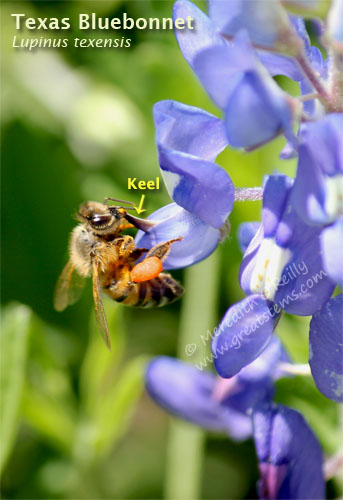
When a visiting bee lands on a bluebonnet floret’s wing petals, its weight lowers those petals to expose the keel, which is actually two petals that protect the floret’s reproductive parts, the stamens (which produce the pollen) and the pistil (which receives other pollen and produces seed). Here the bee collects pollen, naturally leaving other pollen grains behind to fertilize the floret, and when the bee flies to other florets, the wing petals return to their protective position over the keel. As the bee visits floret after floret, more pollination occurs. Florets that are not pollinated will not set seed.
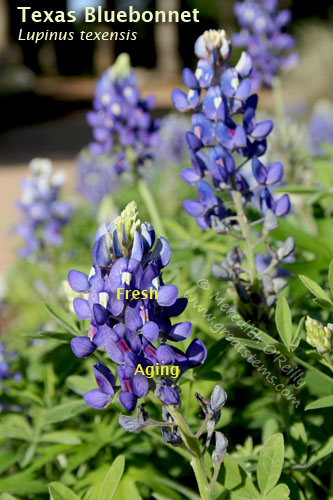 Any given bluebonnet is likely to show both fresh florets and aging florets. Even though a magenta banner spot indicates that a floret’s pollen has lost its viability, the floret may, of course, produce seeds if it was pollinated while it was fresh.
Any given bluebonnet is likely to show both fresh florets and aging florets. Even though a magenta banner spot indicates that a floret’s pollen has lost its viability, the floret may, of course, produce seeds if it was pollinated while it was fresh.
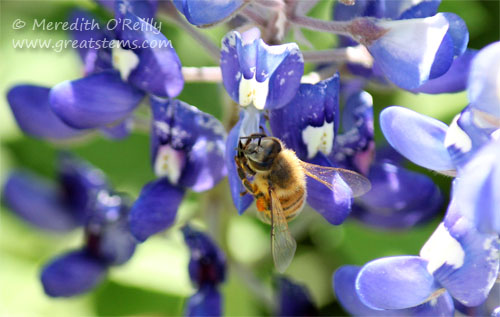 Because bluebonnets cannot self-fertilize, the decline in bee populations has a direct effect on how many seeds a bluebonnet can produce. One plant has the potential to produce many hundreds of seeds, but often only a small number typically result, simply due to the decrease in pollinator numbers. Please protect our pollinators and our wildflowers by not using pesticides!
Because bluebonnets cannot self-fertilize, the decline in bee populations has a direct effect on how many seeds a bluebonnet can produce. One plant has the potential to produce many hundreds of seeds, but often only a small number typically result, simply due to the decrease in pollinator numbers. Please protect our pollinators and our wildflowers by not using pesticides!
Another danger to bluebonnets and other native wildflowers, is the invasive Bastard Cabbage, a yellow flower of the mustard family (my son still prefers to call it Bad Word Cabbage, which seems equally appropriate). Active measures must be taken to control this bullying plant, whether it be mowing before the cabbage flowers go to seed, removing each entire plant with its tap roots, or overseeding with native plants such as Indian Blanket (Gaillardia). Studies are being done to determine the best course of action, but in the meantime, if you see Bastard Cabbage, yank it out if you can.
Here in Texas, we have 6 known native species of bluebonnets, and all are considered our state flower. There’s a long history regarding the bluebonnet’s status in Texas. When the bluebonnet was chosen as our state flower back in 1901, beating out the cotton boll and the prickly pear flowers, the Sandyland species Lupinus subcarnosus was recorded. But in the years following, many people felt the ever-popular Lupinus texensis, or Texas Bluebonnet, was a better choice. Both are endemic to Texas, but then what about our other larger-range and equally beautiful bluebonnets, such as the taller Big Bend Bluebonnet (Lupinus havardii)? In 1971 Texas legislators amended the law, stating that all native species of bluebonnet in Texas were our state flower. Problem solved.
Even before Texans fell in love with the bluebonnet, this attractive flower was the subject of lore and legend for Native Americans in the area, many of whom considered the bluebonnet a gift from the Great Spirit. One story is that the bluebonnets arrived with rain after a young orphaned girl sacrificed her precious doll to the Great Spirit in hopes of bringing an end to a terrible drought. Spanish explorers and missionaries upon their arrival in Texas also admired the blue-blooming flowers. The bluebonnet has been called el conejo (“the rabbit” — possibly for the tail-like tuft of new florets at the top of each Texas bluebonnet flower), Wolf Flower (hence the Lupinus genus), and Buffalo Clover.

Our puppy in 2009 — he’s all grown up now!
A final note: It’s not actually illegal to pick bluebonnets, but it’s considered very rude and improper. We need bluebonnets to go to seed — please don’t pick them! And try very hard not to trample them while you are out picture taking!
And suddenly spring is here! I won’t pretend that I was too active in the garden over the winter, but the garden seems to be doing fine all the same. Buds and blooms and freshly emerging greenery abound, with lots of pollinators and birds and other critters keeping the garden in constant motion.
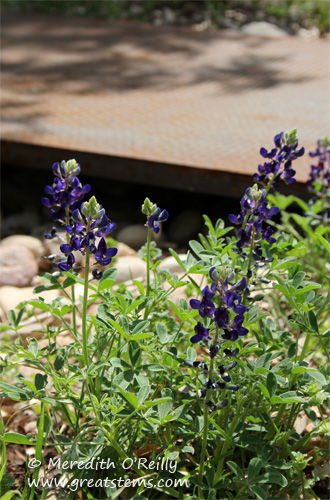 Out by the new dry creek bed, the bluebonnets are in bloom. I am ever so happy I planted these along the street — what a cheery and very Texan way to greet the neighbors. We continue to be very pleased with our creek bed — it is such a visual improvement over the trench that once was there. It looks like most of the other plants along the creek have made it through the winter — once they are a little bigger, I’ll give a report on the different species we planted.
Out by the new dry creek bed, the bluebonnets are in bloom. I am ever so happy I planted these along the street — what a cheery and very Texan way to greet the neighbors. We continue to be very pleased with our creek bed — it is such a visual improvement over the trench that once was there. It looks like most of the other plants along the creek have made it through the winter — once they are a little bigger, I’ll give a report on the different species we planted.
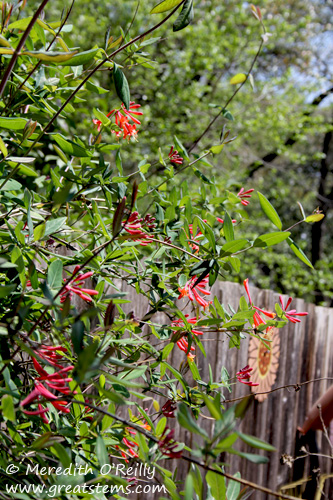 In the backyard, the Coral Honeysuckle is so dense and tall that I think this year it will finally spill over the fence.
In the backyard, the Coral Honeysuckle is so dense and tall that I think this year it will finally spill over the fence. 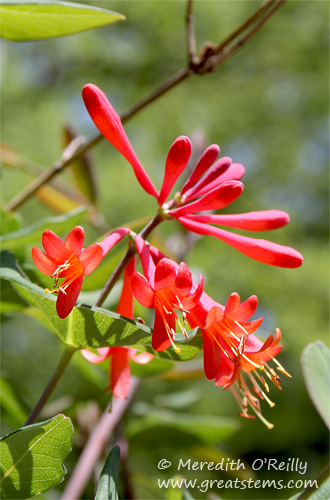 Hopefully my neighbor will enjoy the blooms — he loves color in the garden.
Hopefully my neighbor will enjoy the blooms — he loves color in the garden.
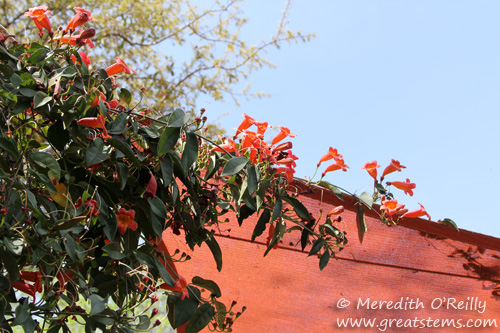 The Crossvine near the backyard shade sails is heavy with blooms (there were even more blooms a couple of days ago, but in typical fashion I forgot to put the memory card in the camera when I took pics that day — alas). We love the creeping vines and blooms working their way along the edge of the sails.
The Crossvine near the backyard shade sails is heavy with blooms (there were even more blooms a couple of days ago, but in typical fashion I forgot to put the memory card in the camera when I took pics that day — alas). We love the creeping vines and blooms working their way along the edge of the sails.
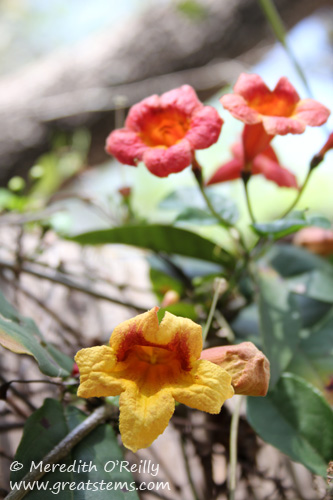 But here’s a mystery — over in the shade my original Crossvine plant, the native yellow-exterior variety, is doing something odd. Part of it is blooming yellow as expected, but the same plant is simultaneously producing orange-exterior blooms. What on earth is going on? There hasn’t been any change to the soil, but we did have a very mild winter — is it a temperature thing? I don’t want to lose my yellow blooms — they are my favorite! I’m trying not to feel alarmed, but I can’t help it!
But here’s a mystery — over in the shade my original Crossvine plant, the native yellow-exterior variety, is doing something odd. Part of it is blooming yellow as expected, but the same plant is simultaneously producing orange-exterior blooms. What on earth is going on? There hasn’t been any change to the soil, but we did have a very mild winter — is it a temperature thing? I don’t want to lose my yellow blooms — they are my favorite! I’m trying not to feel alarmed, but I can’t help it!
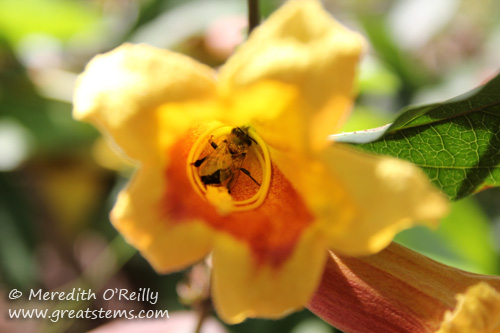 The honeybees don’t seem to mind the change — they visit the yellow and orange blooms with equal interest.
The honeybees don’t seem to mind the change — they visit the yellow and orange blooms with equal interest.
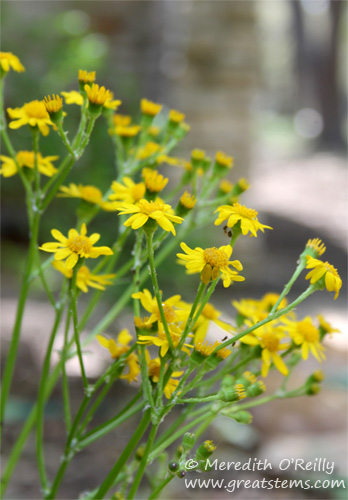 This year, I’m excited to see my Golden Groundsel blooming for the first time. Let’s hope it reseeds and makes babies.
This year, I’m excited to see my Golden Groundsel blooming for the first time. Let’s hope it reseeds and makes babies.
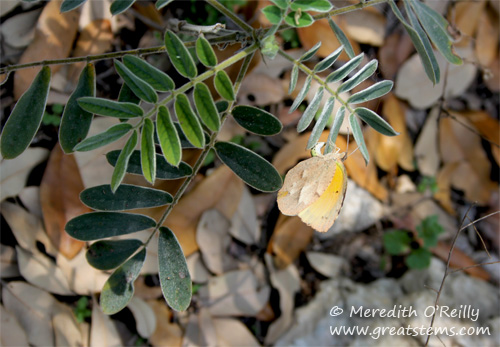 Sulphur butterflies, several species of them, have been busy laying eggs all over the Lindheimer’s Senna, which has barely had a chance to really show its spring face. But that’s par for the course — it’s the host plant for many Sulphur species, such as Sleepy Orange, Cloudless, Southern Dogface, Large Orange, and others. Eggs dot the tops and bottoms of the leaves — I can’t wait to see the caterpillars. I’m not worried about the number — I’ve got plenty of Lindheimer’s Senna to go around. I’ve never seen this many Sulphurs in the yard — can you guess how much I’m loving it? Lots!
Sulphur butterflies, several species of them, have been busy laying eggs all over the Lindheimer’s Senna, which has barely had a chance to really show its spring face. But that’s par for the course — it’s the host plant for many Sulphur species, such as Sleepy Orange, Cloudless, Southern Dogface, Large Orange, and others. Eggs dot the tops and bottoms of the leaves — I can’t wait to see the caterpillars. I’m not worried about the number — I’ve got plenty of Lindheimer’s Senna to go around. I’ve never seen this many Sulphurs in the yard — can you guess how much I’m loving it? Lots!
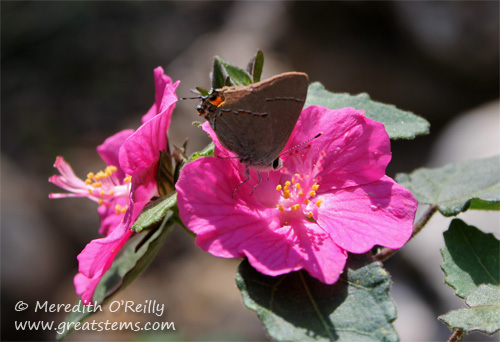 Gray Hairstreaks are visiting the garden, as well — this one on Rose Pavonia. Every time I see one, I think about how scientists are realizing that spiders might play an important part in the defensive coloration of butterflies (birds had long been considered the primary suspects involved). The “head” at the tip of the butterflies’ wings is a visual distraction, and small predators such as jumping spiders mistakenly aim for the wing tip instead of the actual head of the butterfly, which means the butterfly has a chance to escape. The same false head is less effective against birds, it turns out.
Gray Hairstreaks are visiting the garden, as well — this one on Rose Pavonia. Every time I see one, I think about how scientists are realizing that spiders might play an important part in the defensive coloration of butterflies (birds had long been considered the primary suspects involved). The “head” at the tip of the butterflies’ wings is a visual distraction, and small predators such as jumping spiders mistakenly aim for the wing tip instead of the actual head of the butterfly, which means the butterfly has a chance to escape. The same false head is less effective against birds, it turns out.
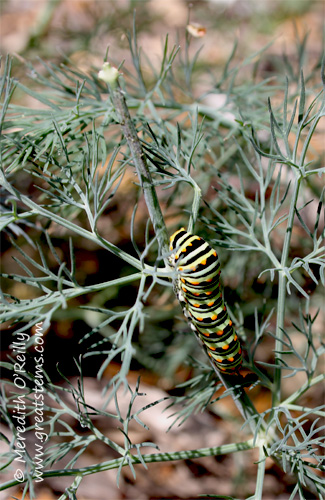 I was thrilled to discover that our dill and fennel are covered in Black Swallowtail caterpillars. In the fall I decided to be brave and plant the dill in one of the main garden beds, deciding that I’d be okay if it reseeds to abundance (the fennel is in its own container). Given my delight over the caterpillars, I feel confident that I made the right choice. But of course, we’ll see how much dill shows up next year!
I was thrilled to discover that our dill and fennel are covered in Black Swallowtail caterpillars. In the fall I decided to be brave and plant the dill in one of the main garden beds, deciding that I’d be okay if it reseeds to abundance (the fennel is in its own container). Given my delight over the caterpillars, I feel confident that I made the right choice. But of course, we’ll see how much dill shows up next year!
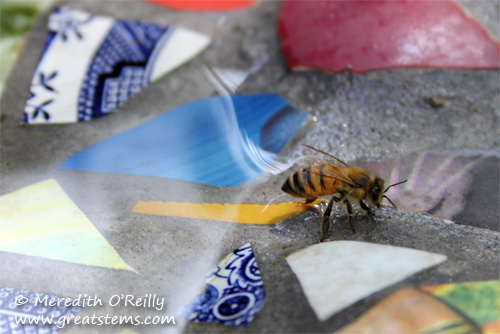 The mosaic birdbath is popular, and not just with birds. Squirrels and bees visit it, too — and who knows what else. It was fascinating watching the bees today — some collected water by skimming over the surface for a quick drink, but others preferred to stand on the side and drink safely at their leisure.
The mosaic birdbath is popular, and not just with birds. Squirrels and bees visit it, too — and who knows what else. It was fascinating watching the bees today — some collected water by skimming over the surface for a quick drink, but others preferred to stand on the side and drink safely at their leisure.
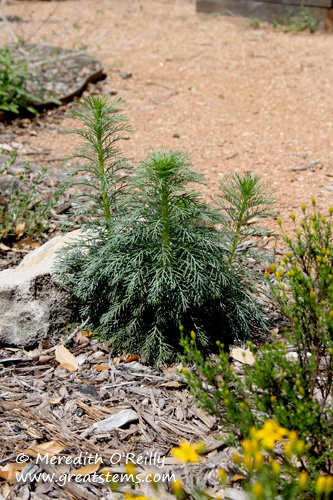 I’ve got many Standing Cypress plants now in their second year, and the flower spikes are already on their way up. They will grow big and tall by the time they are ready to show their vibrant red flowers — which the hummingbirds will go crazy for!
I’ve got many Standing Cypress plants now in their second year, and the flower spikes are already on their way up. They will grow big and tall by the time they are ready to show their vibrant red flowers — which the hummingbirds will go crazy for!
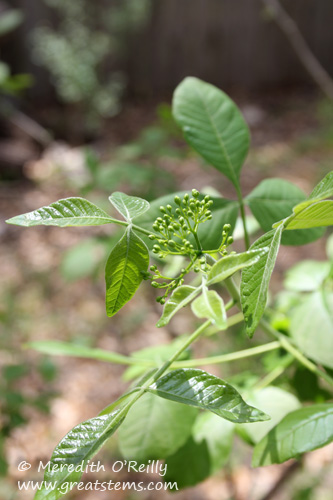 The Wafer Ash is even closer to blooming. With luck, I’ll actually see the flowers this year (usually they are sneaky, and the blooms come and go before I notice).
The Wafer Ash is even closer to blooming. With luck, I’ll actually see the flowers this year (usually they are sneaky, and the blooms come and go before I notice).
Despite all the blooms, the garden is still in a state of transition. From a distance, many of trees and shrubs still look somewhat bare as the buds emerge, while others are already fully green and working on their flowers. That’s okay — it’s still early in the season, and all I care about are that things are growing and alive. I’m a pleased gardener.